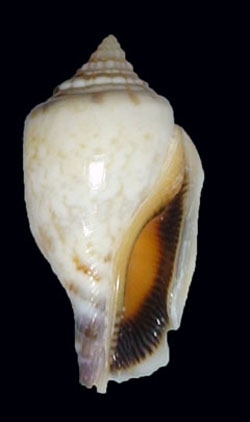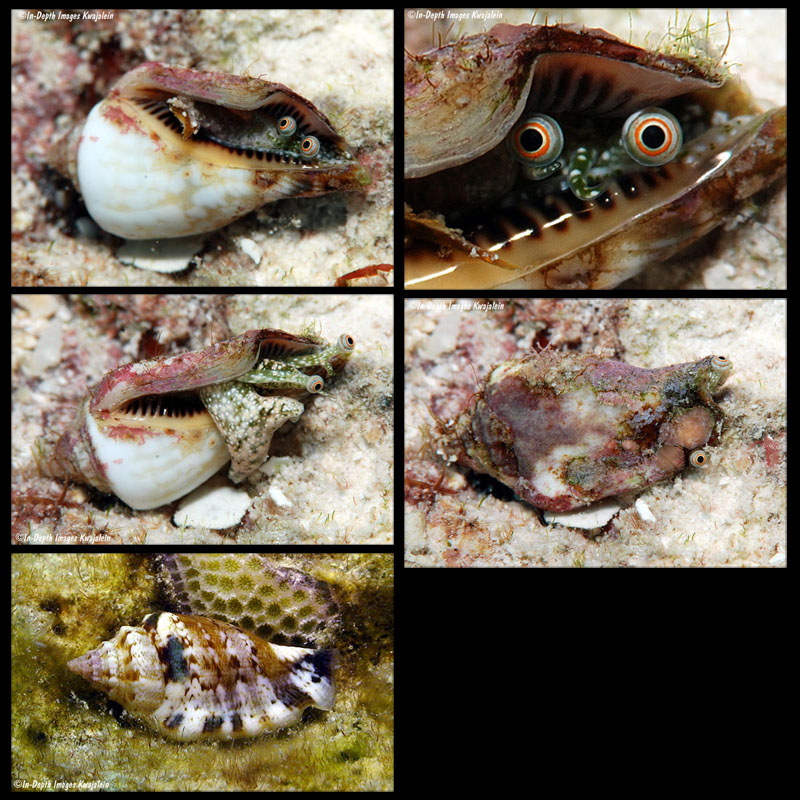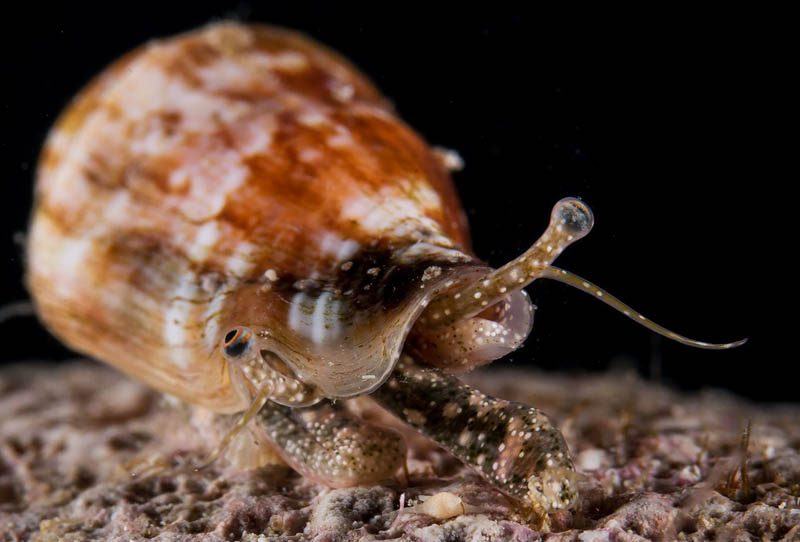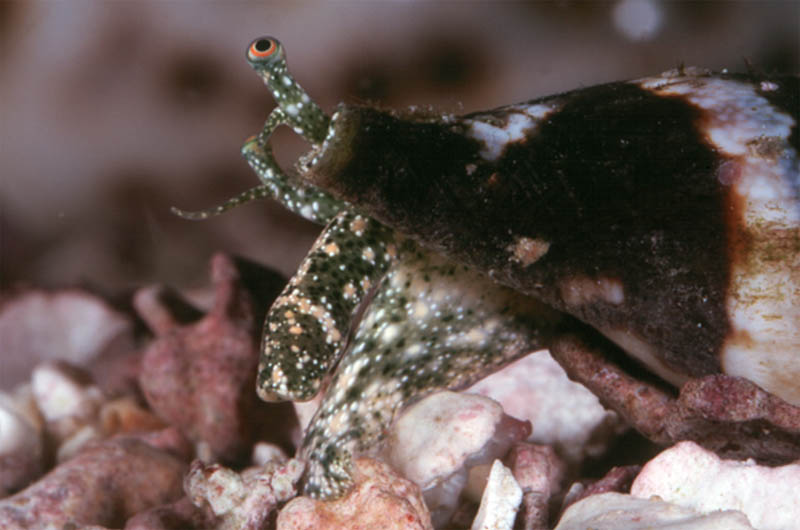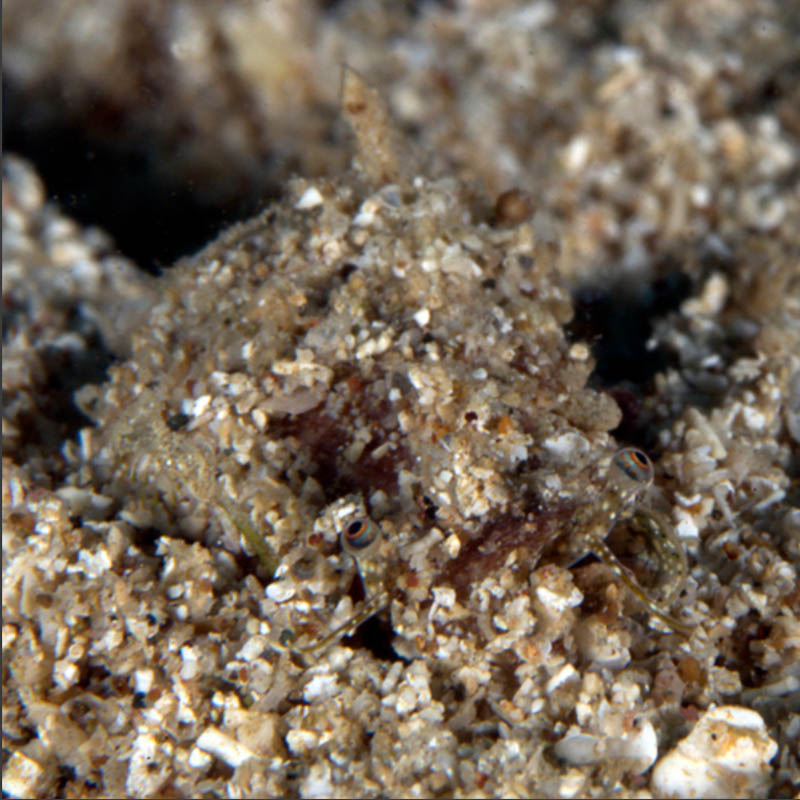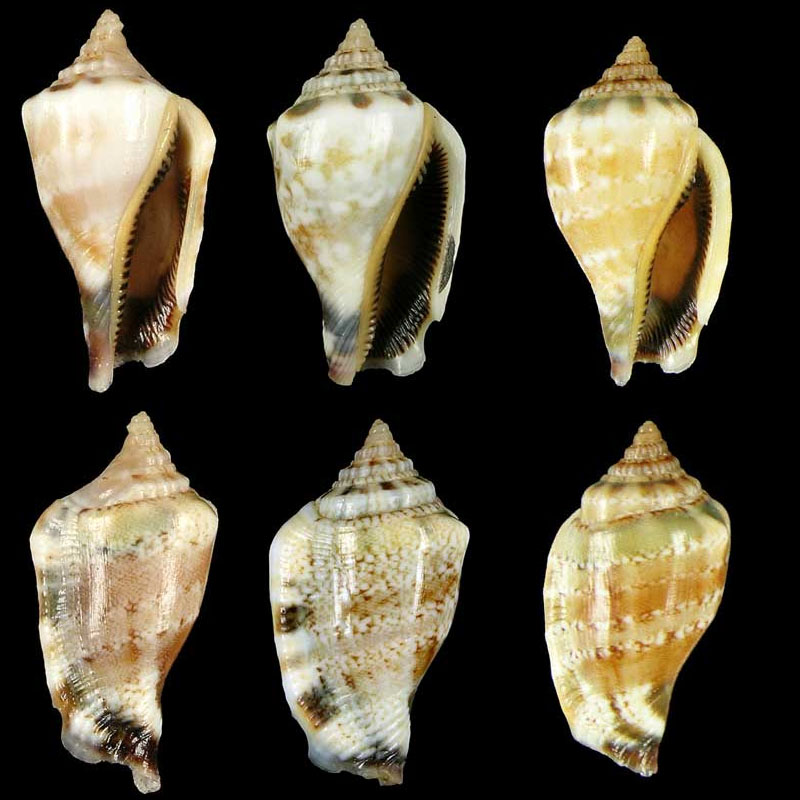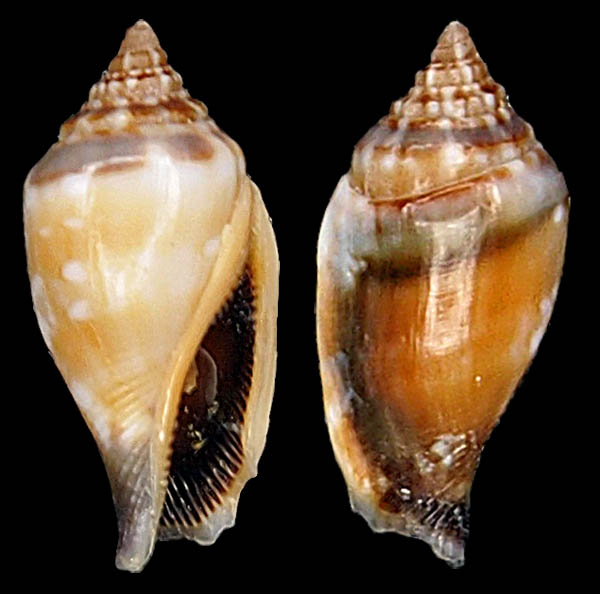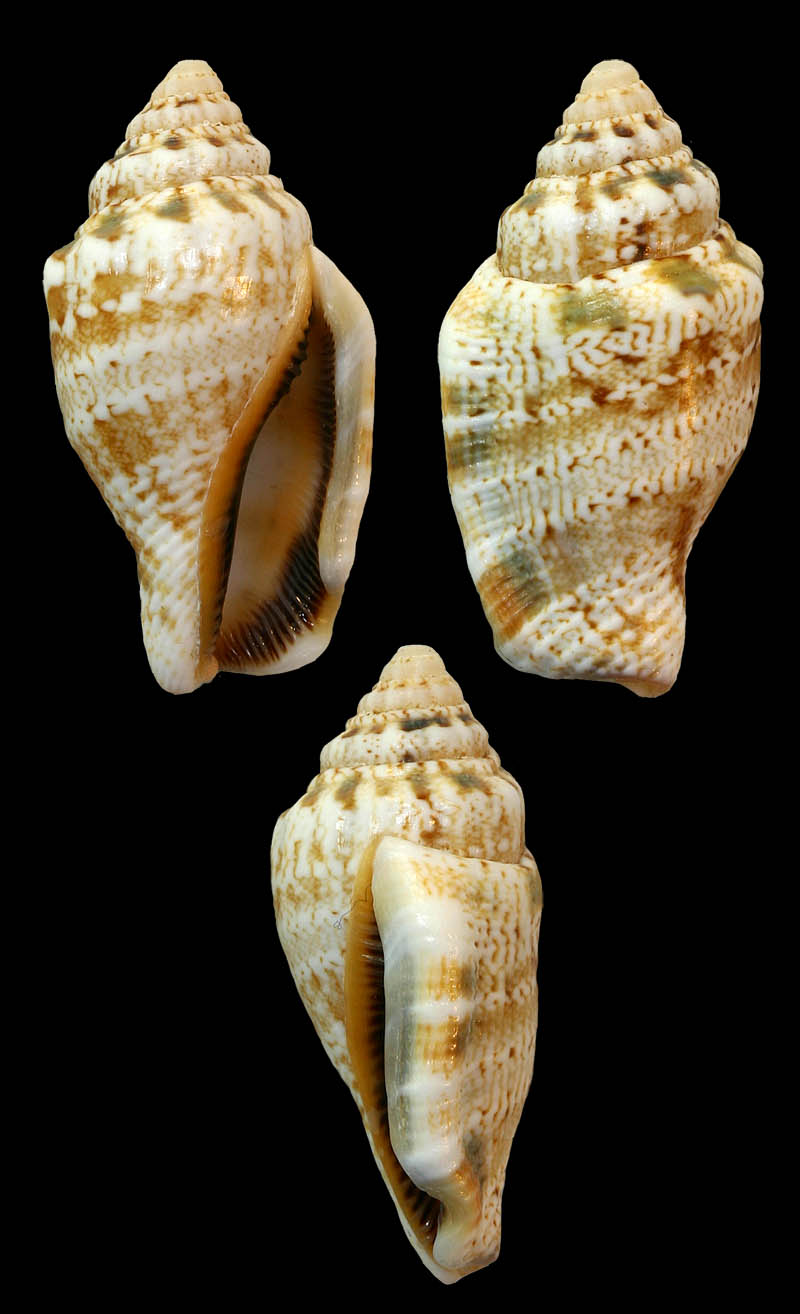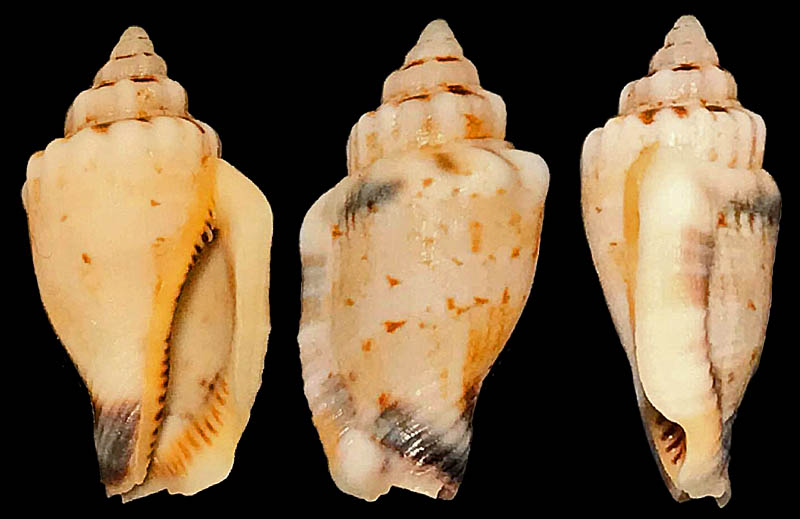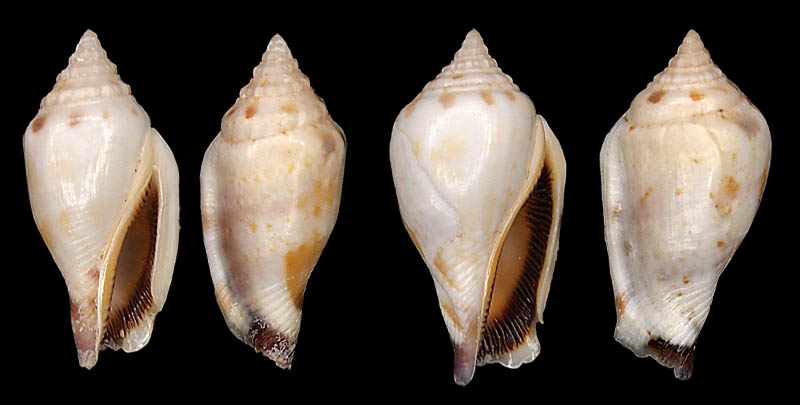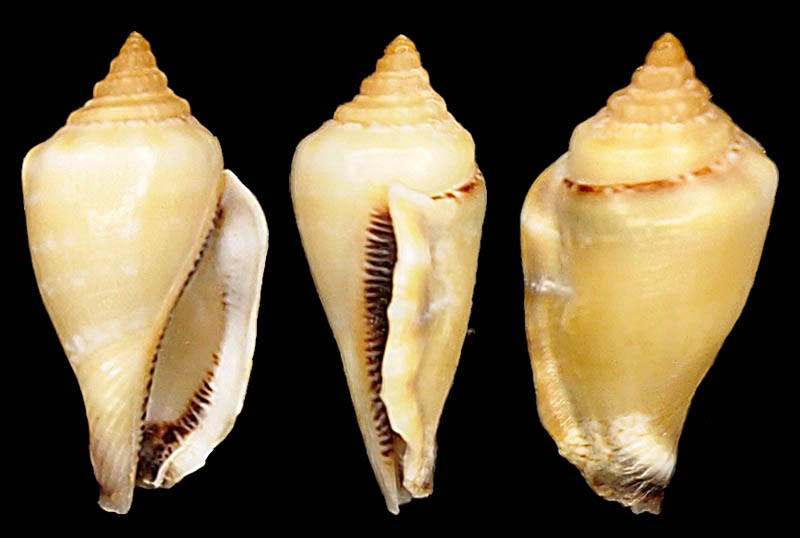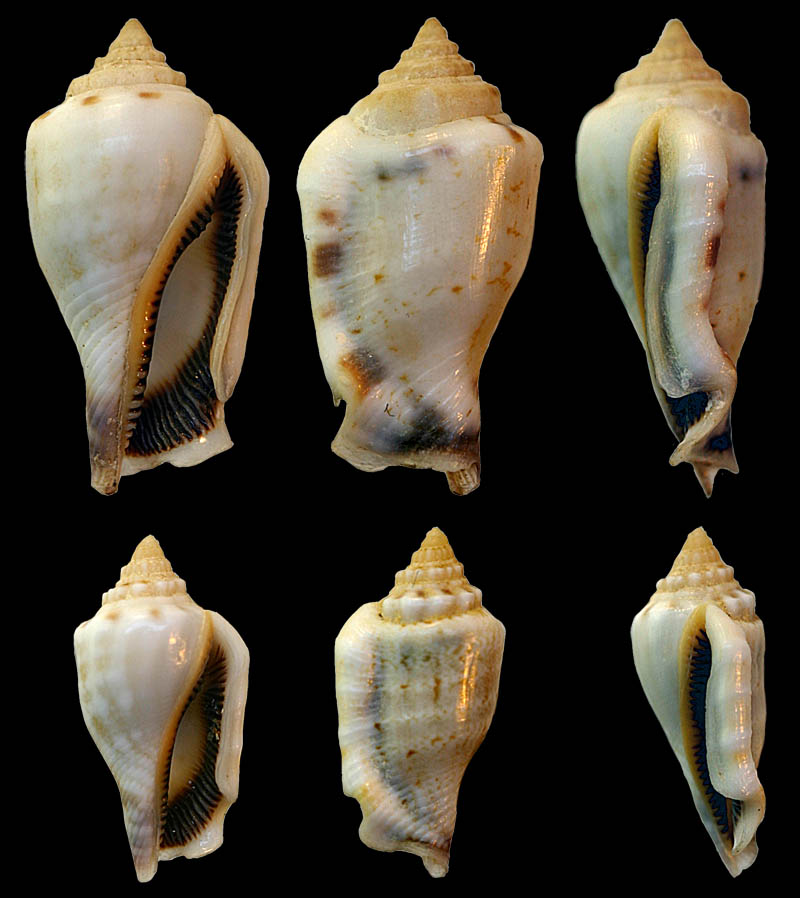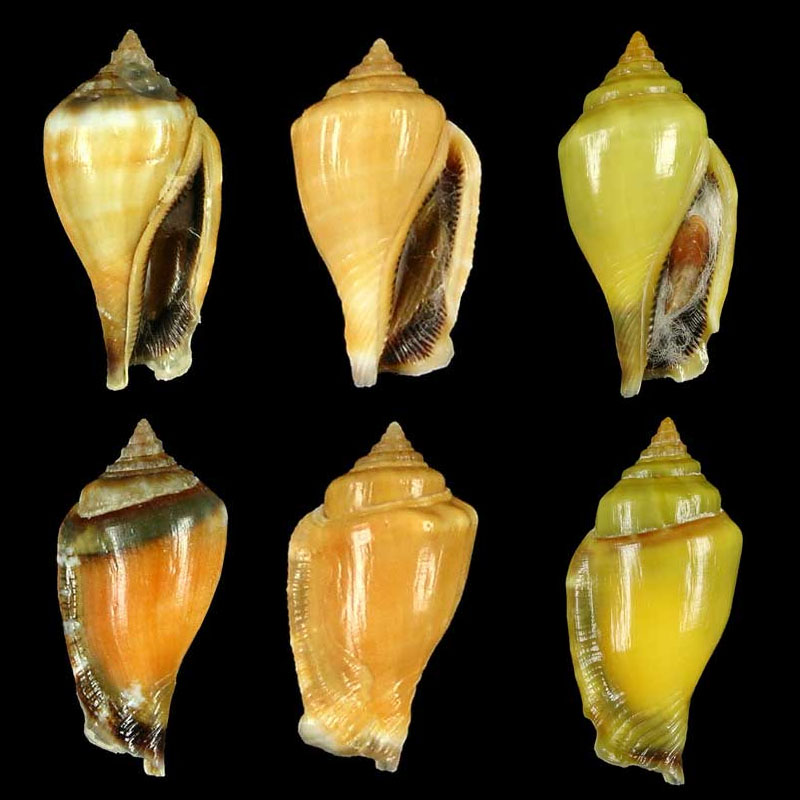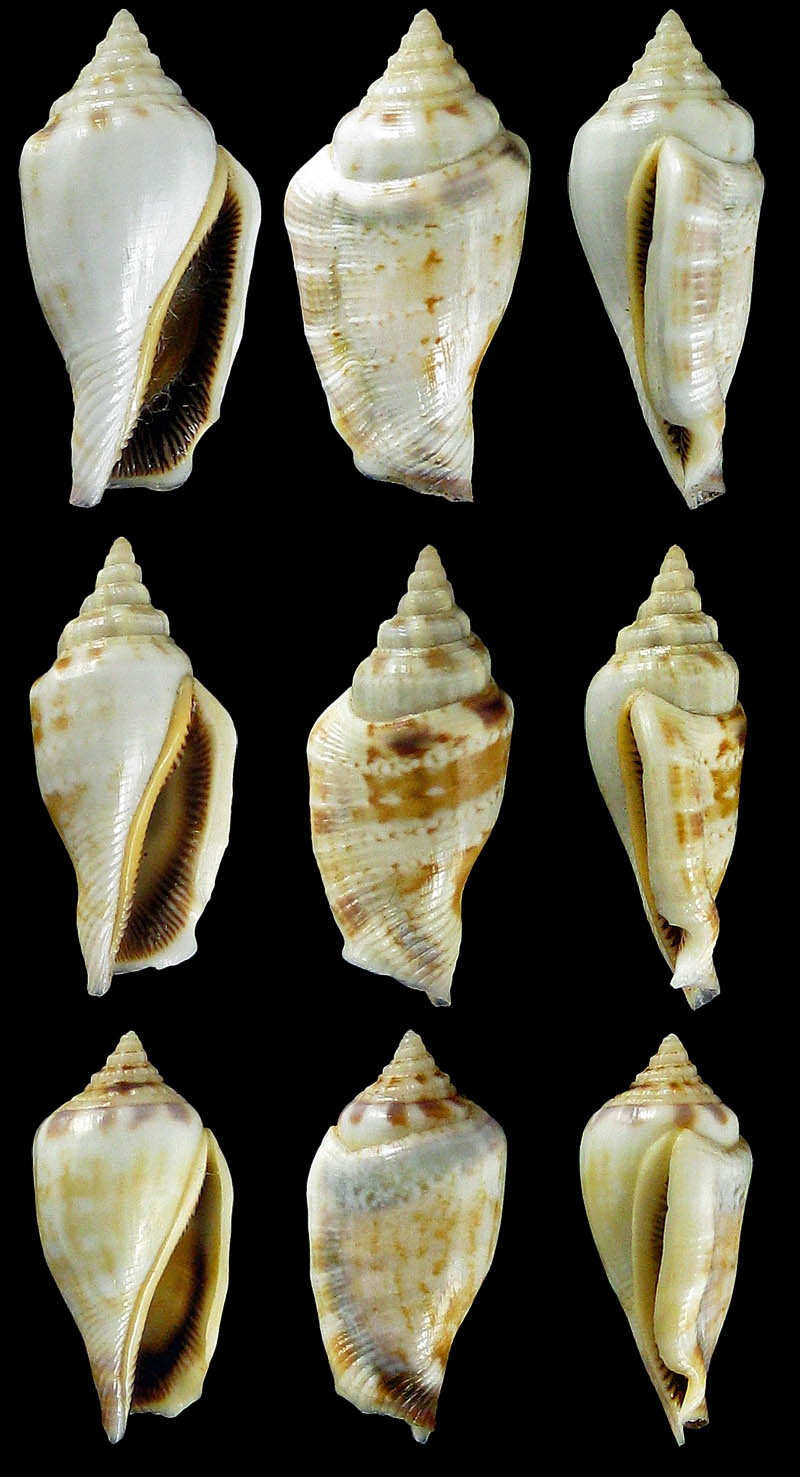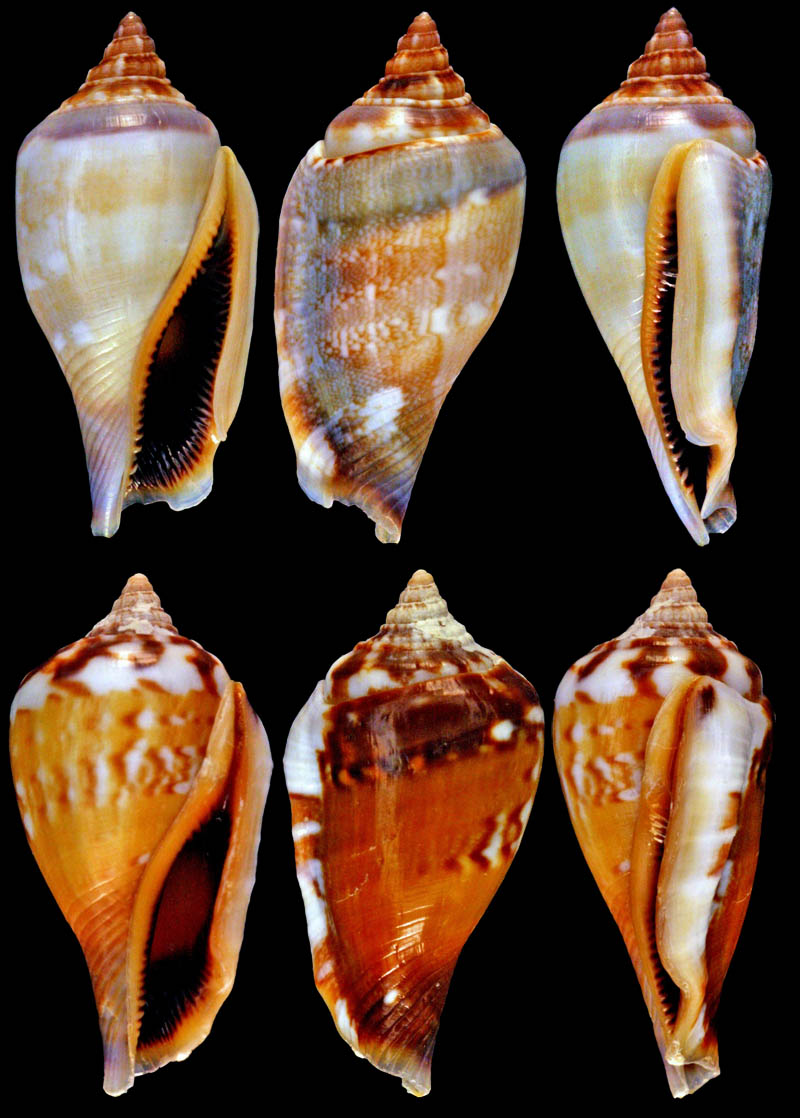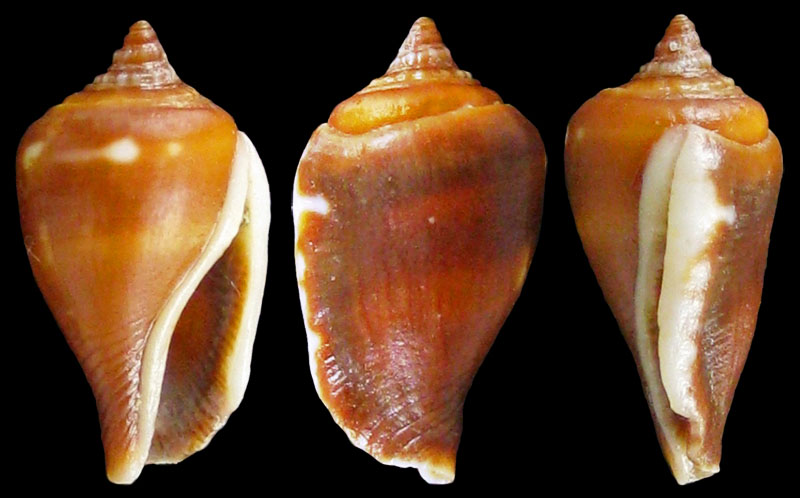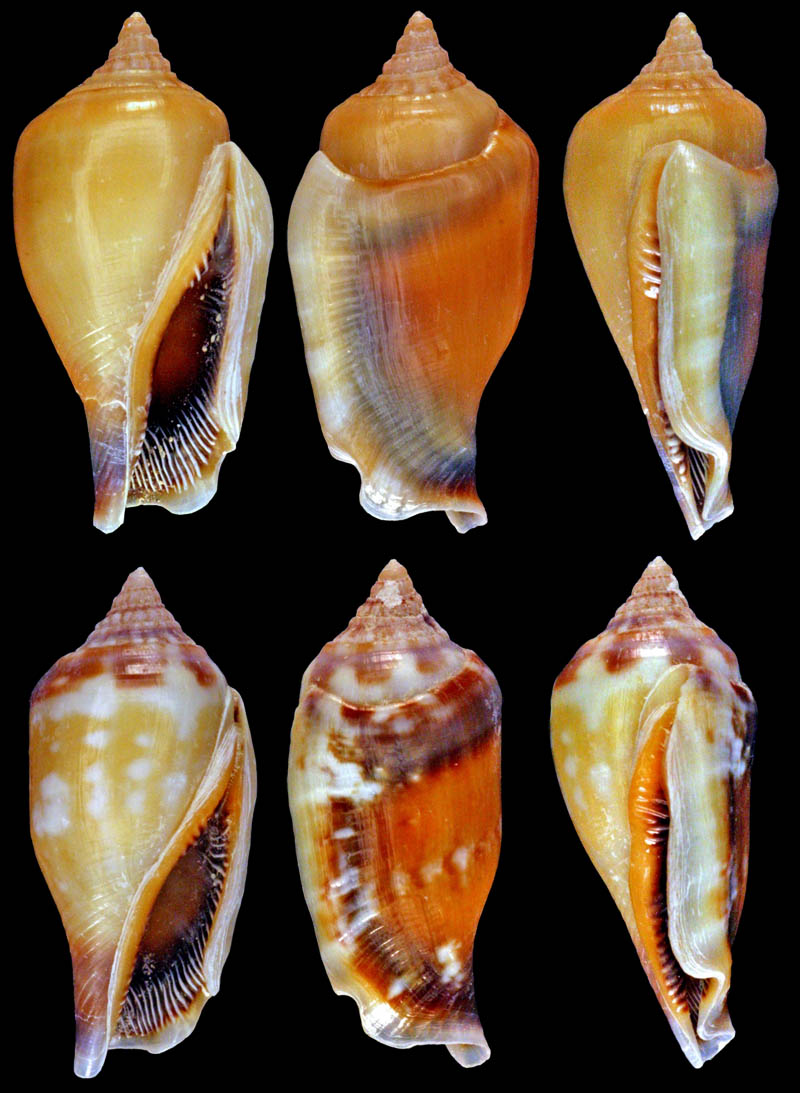|
edit SideBar
|
Species / Canarium Microurceus
Stromboidea
History and Synonymy
Canarium microurceus Kira, 1959: 37, pl. 15 fig. 5 [as Canarium microurceum but see Willan & Kronenberg, 2004] [not available from Kira 1954 = nom. nud.]
- syn. Strombus floridus Lamarck Lischke, 1871:23
1871
Lischke, 1871, p. 23 on Strombus floridus:
- Kiusiu, Japan
- "Ein kleines, nur 25 Millim. langes Exemplar mit niedrigem Gewinde und schwach entwickelten Knoten des letzten Umganges. Die Aussenseite ist ganz so gefärbt, wie dies bei mehreren meiner Exemplare aus dem Rothen Meere der Fall ist, nämlich auf weisslichem Grunde rothbraun gewölkt und netzförmig gezeichnet, der letzte Umgang unter der Naht und gegen die Mündung hin grünlich grau, mit breiter, heller Mittelbinde und einigen schmalen, braun und weiss gegliederten Spirallinien versehen. Dagegen hat die Mündung eine auffallende Färbung. Statt, wie gewöhnlich, rosenroth oder weisslich zu sein, ist sie gelblich und in den Zwischenräumen der die Spindel und die Aussenlippe dicht bedeckenden Falten schwarzbraun. Ich finde weder bei einem meiner zahlreichen Exemplare des Str. floridus, noch in einer der Beschreibungen oder Abbildungen desselben eine Andeutung solcher Färbung. Aber in Betreff mancher anderen Strombusarten, z.B. Str. gibberulus Linné und Str. urceus Linné, sind ja ganz ähnliche Schwankungen in der Mündungsfarbe längst bekannt."
1982
Ladd, 1982, p. 34:
- "Two incomplete and slightly worn shells from a drill hole in the Nandi area, Viti Levu, Fiji (station C2173) seem to represent this Holocene species that is known from the western Pacific - from Northern Australia to Japan and eastward to Fiji and Samoa. The shells from C2173 are probably Pliocene in age and are the first recorded fossil occurrence. The figured specimen, USNM 214380, measures: length 24,8 mm, diameter 11,6 mm."
Springer, 1982, p. 106:
- "Strombus maculatus is a widely distributed Pacific Plate endemic (Figure 47). Abbott stated that S. maculatus, S. microurceus, and 5. mutabilis form a natural group within the subgenus Canarium. These three species have quite different distributions. Strombus microurceus ranges through much of the western Pacific, but occurs nonmarginally on the Pacific Plate only in the Eastern Caroline Islands, where it is sympatric with S. maculatus (Abbott, 1960, plate [= figure] 47). The presence of S. microurceus in the Eastern Carolines is evidence favoring operation of the Caroline Islands conduit. Strombus mutabilis ranges from the Red Sea and east coast of Africa to the Tuamotus, and thus overlaps most of the range of the other two species (it is absent from the Hawaiian Islands; Abbott, 1960, plate 50). If S. microurceus is the sister species of S. maculatus, and there is a good chance that it is, the Pacific Plate boundary is probably the area where the vicariant event occurred that divided the ancestral population that gave rise to these two species. Subsequent dispersal would then have resulted in the partial sympatry of these two species in the Eastern Caroline Islands. The distributions of the three species of the subgenus Canarium closely parallel the distributions of the three species of the gobiid fish genus Nemateleotris (Figure 21)."
1987
Kay & Johnson, 1987, p. 112 reported Strombus microurceus from Enewetak Atoll
1994
Wells, 1994, p. 8, reported Strombus microurceus from the Cocos (Keeling) Islands
1999
Kreipl et al., 1999, p. 36:
- Range: Southern Japan through the Philippines to Indonesia, northern Australia, Melanesia, and to Samoa
- Size: Adults 14 to 30 mm
- Description: Shell solid, smoothish, and somewhat Quadrate in shape. Spire low, Body whorl smooth with smooth shoulder or with 3-6 low, blunt knobs. Columellar allus thick, with fine spiral lirae that are weak at the Center of the callus. Aperture rather narrow, usually not reaching the shoulder: Outer lip thickened. Basic Color usually cream to White overlaid with Brown and/or yellowish maculations, suffused spiral bands and/or Minute stripes or bars.Outside of base of shelltypically with a distinct blackish-brown patch; sometimes a greenish blotch on the shoulder behind the lip. Columellar callus bicolored, yellowish-orange along the outer border, blackish to dark purple-brown within aperture, with 22-32 fine yellowish lirae. Deep interior of aperture dirty White to yellowish; inside of outer lip with a wide band of dark purple-brown.
Reports
Jeanette & Scott Johnson on Canarium microurceus from Kwajalein Atoll:
- "Canarium microurceus is a rather uncommon species found primarily at depths of 10 to 25m on the seaward reef slope, although occasional specimens are seen on lagoon pinnacles or the interisland lagoon reef."
All Photos of Kwajalein Atoll-specimens above courtesy Scott & Jeanette Johnson, Kwajalein Atoll
Bob Abela on Canarium microurceus from Guam:
- "The shell is about 10mm. A common species on Guam. I placed a few in the aquarium to feed a small Conus legatus."
- "They may be found on the reef or in sand, as here, ~35 ft. Agat Bay, Guam; 28 July 2007
Specimens from private collections
Canarium microurceus Kira, 1959; Philippines; Coll. Guido Poppe
- l: Olango Island, Cebu Province, Central Visayas Region; collected by local fishermen, 2007; 16.4 mm; no. 423055
- m: Olango Island, Cebu Province, Central Visayas Region; 10-25 m; 2009; 18.8 mm; no. 537785
- r: Caubian Island; taken at 4 m, collected by local fishermen; 2009; 18.8 mm; no. 508867
Canarium microurceus Kira, 1959; Barracuda Rock, Guam Island, Mariana Islands, Micronesia, USA, North Pacific Ocean; taken by diver in sand at 10-15 m; 16,8 mm; 5/2007; Coll. Aart Dekkers no. STR1112
Canarium microurceus Kira, 1959; Senggigi, Lombok, Indonesia; 23,4 mm; 3/2007; Coll. Ulrich Wieneke
Canarium microurceus Kira, 1959; Minnie Waters, northern NSW, Australia; 18,8 mm; 4/2018; Coll. Gavin Nichols
Canarium microurceus Kira, 1959; Kwajalein Island, Marshall Islands, Micronesia, North Pacific Ocean; on rubble at 10 feet; r: 22 mm, l: 23,2 mm; 1986; Coll. Aart Dekkers no. STR0761
Canarium microurceus Kira, 1959; Balut Island, Sarangani Islands group, Davao Occidental Province, Davao Region, Philippines; tangle nets in 100-150 fathoms; 17,2 mm; 12/2007; Coll. Aart Dekkers no. STR1111
Canarium microurceus Kira, 1959; Salalihra, Western Samoa, Polynesia; t:20,1 mm, b:14,8 mm; 2/2007; Coll. Ulrich Wieneke
- The lot contains further C. microurceus with the heights: 11,4 mm, 13,5 mm; 14,9 mm, 17,4 mm, 20,3 mm, 21,0 mm,23,1 mm
Canarium microurceus Kira, 1959; colour Variation; Philippines Islands; Coll. Guido Poppe
- l: Liloan, Cebu Island, Central Visayas Region; collected at 30-35 m, from local fisherman; 2009; 26.1 mm; no. 501377
- m: Panay Island, Capiz Province, Western Visayas Region; from fishermen; 10-25 m; 2007; 25.6 mm; no. 419614
- r: Olango Island, Cebu Province, Central Visayas Region; collected 20-35 meters deep by local fishermen; 2010; 26.3 mm; no. 585721
- Comment colour forms like the above are rare in the Philippines
Canarium microurceus Kira, 1959; Orote’ Cliffs, Guam Island, Mariana Islands, Micronesia, USA, North Pacific Ocean; 60-80 ft in silt & rubble in sand trenches; 1984; 1.r: 23,5 mm, 2.r: 22 mm, 3. r: 19,5 mm; Coll. Paul Merrill
Canarium microurceus Kira, 1959; Barracuda Rock, Orote Point, Guam Island, Mariana Islands, Micronesia, USA, North Pacific Ocean; in shallow sand pockets, 50 feet, Scuba; 2/1979; t:20,9 mm, b:20,6 mm; Coll. Richard Salisbury
Canarium cf. microurceus Kira, 1959; Orote’ Cliffs, Guam Island, Mariana Islands, Micronesia, USA, North Pacific Ocean; 60-80 ft in silt & rubble in sand trenches; 1984; 16,9 mm; Coll. Paul Merrill
Canarium microurceus Kira, 1959; North Tipalao Point, Guam Island, Mariana Islands, Micronesia, USA, North Pacific Ocean; in shallow sand pockets, 35 feet, Scuba; 3/1978; t:18.8 mm, b:18,4 mm; Coll. Richard Salisbury
References
- E. Alison Kay & Scott Johnson, 1987. Mollusca of Enewetak Atoll, in D.M. Devaney, 1987, The Natural History of Enewetak Atoll, Volume II Biogeography and Systematics, p. 105-146, URL
- Kira, T., 1954. Coloured illustrations of the shells of Japan. Enlarged and revised edition. I-ViII, 1-172 + [24] + 67 pls, Hoikusha, Osaka, Japan.
- Kira, T., 1959. Coloured illustrations of the shells of Japan. Enlarged and revised edition. I-VII, 1-239 + 71 pls, Hoikusha, Osaka, Japan
- Kreipl et al., 1999
- H.S. Ladd, 1982. Cenozoic Fossil Mollusks from Western Pacific Islands; Gastropods (Eulimidae and Volutidae through Terebridae), Geological Survey Professional Paper 1171, United States Government Printing Office, Washington. fulltext
- C.E. Lischke, 1871. Japanische Meeres-Conchylien. Ein Beitrag zur Kenntnis der Mollusken Japan's mit besonderer Rücksicht auf die geographische Verbreitung derselben. Zweiter Theil. Cassel, Verlag Theodor Fischer, pp. 1-184. Fulltext
- Springer, Victor G., 1982. Pacific Plate Biogeography, with Special Reference to Shorefishes, Smithsonian Contributions to Zoology, no. 367, pp. 182, URL
- Willan, R.C. & Kronenberg, G.C., 2004. Rectification of nomenclature for two species in the family Strombidae (Gastropoda, Caenogastropoda). Basteria 67 (4-6): 153-158.
- Wells, F. E., 1994. Marine Molluscs of the Cocos (Keeling) Islands. Atoll Research Bulletin; no. 410, URL
|

